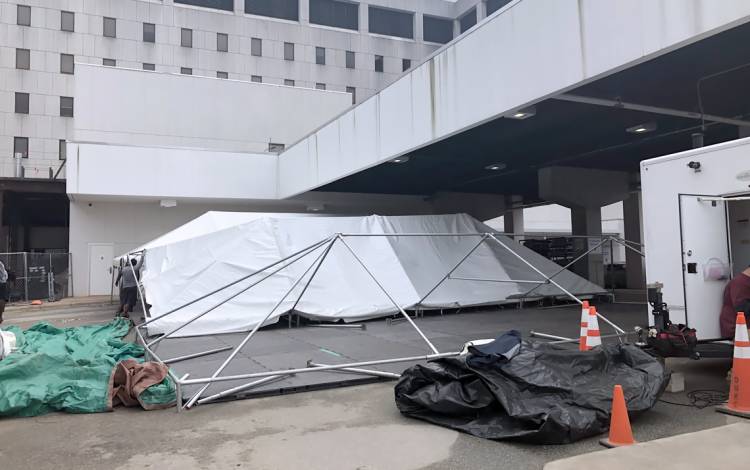Duke Health Triage Tents Provide COVID-19 Care
Tents outside Duke University and Duke Regional hospitals provide specialized treatment during the pandemic

Duke Health has assembled triage tents at two of its system hospitals to provide specialized care for patients with COVID-19 symptoms.
The tents act as extensions of emergency rooms at Duke University Hospital and Duke Regional Hospital in Durham to separate and protect patients during the pandemic.
“The complete strength of Duke has come together to address this response,” said Jason Zivica, director of emergency preparedness and business continuity for Duke Health. “We’re successfully managing this because our employees have come together as a team to proactively respond across our entire organization.”
 In addition, to help prevent the spread of COVID-19, some urgent care centers will be converted to respiratory care clinics to only treat people with symptoms such as congestion, runny nose, cough, fever and shortness of breath.
In addition, to help prevent the spread of COVID-19, some urgent care centers will be converted to respiratory care clinics to only treat people with symptoms such as congestion, runny nose, cough, fever and shortness of breath.
As of 11 a.m. April 8, there are 3,426 cases of COVID-19 in the state of North Carolina and 53 deaths, according to the state Department of Health and Human Services, which maintains a dashboard of cases in the state.
At Duke University Hospital, two tents were built next to the Emergency Department and in a nearby parking lot. Patients who need emergency medical care unrelated to COVID-19 are directed to the emergency room, while patients who are experiencing virus symptoms are directed to the emergency tents.
The tents next to the emergency department, both 19 feet by 35 feet, include waiting and treatment areas for up to 40 patients with potential respiratory illness. Nurses and physicians screen patients in the tents to determine if they need to be admitted or sent home.
 Duke’s Healthcare Preparedness Coalition, a division of the Duke Trauma Center that assists in planning, mitigating and responding to disaster events, oversaw assembly of the Duke University Hospital tents, along with help from Duke Health Technology Solutions, Duke Hospital Emergency Department and Duke Health Engineering & Operations.
Duke’s Healthcare Preparedness Coalition, a division of the Duke Trauma Center that assists in planning, mitigating and responding to disaster events, oversaw assembly of the Duke University Hospital tents, along with help from Duke Health Technology Solutions, Duke Hospital Emergency Department and Duke Health Engineering & Operations.
“I’ve never seen the Duke Health System mobilize in this way before,” Zivica said. “We’ve adapted the way we provide health care in a matter of weeks. It’s a testament to our great team.”
At Duke Regional Hospital, the ambulance bay next to the emergency department now includes four tents to receive patients experiencing COVID-19 symptoms. Patients without respiratory symptoms are directed to the emergency room upon arrival at Duke Regional.
The first of the four tents, at 15 feet by 30 feet, is used to check in patients. The other three tents, each 20 feet by 40 feet, serve as waiting and treatment areas for up to 30 patients and storage for equipment.
 Duke Regional hired an outside contractor to erect the tents with assistance from the hospital’s facilities team, Emergency Department and Procurement and Supply Chain.
Duke Regional hired an outside contractor to erect the tents with assistance from the hospital’s facilities team, Emergency Department and Procurement and Supply Chain.
Jeff Forsyth, supervisor of structural trades at Duke Regional, and his team spent about three days installing electricity, heating, gas, air conditioning and water for the tents.
“The team at Duke Regional is awesome,” Forsyth said. “I wouldn’t go to battle with anyone else.”
The triage tents went into operation the week of March 23 with clinicians from the Emergency Department testing and treating patients showing symptoms of COVID-19.
Zachary Cockerham, nurse manager for the Duke Regional Emergency Department, worked with Forsyth to set up the tents. Cockerham advised on layout and workflow for physical distancing. Cockerham noted how teamwork among colleagues has further deepened the trust and pride employees share with each other and for Duke.
 “One of our values at Duke is excellence, and we always show that,” Cockerham said. “This situation has been ever-changing and unpredictable. Our efforts that have gone forward have been far beyond excellence. It’s incredible to see.”
“One of our values at Duke is excellence, and we always show that,” Cockerham said. “This situation has been ever-changing and unpredictable. Our efforts that have gone forward have been far beyond excellence. It’s incredible to see.”
Help us share the proactive and extensive work being done by all Duke community members during the COVID-19 outbreak. Share ideas, shout-outs and photographs with us here or write us at working@duke.edu.